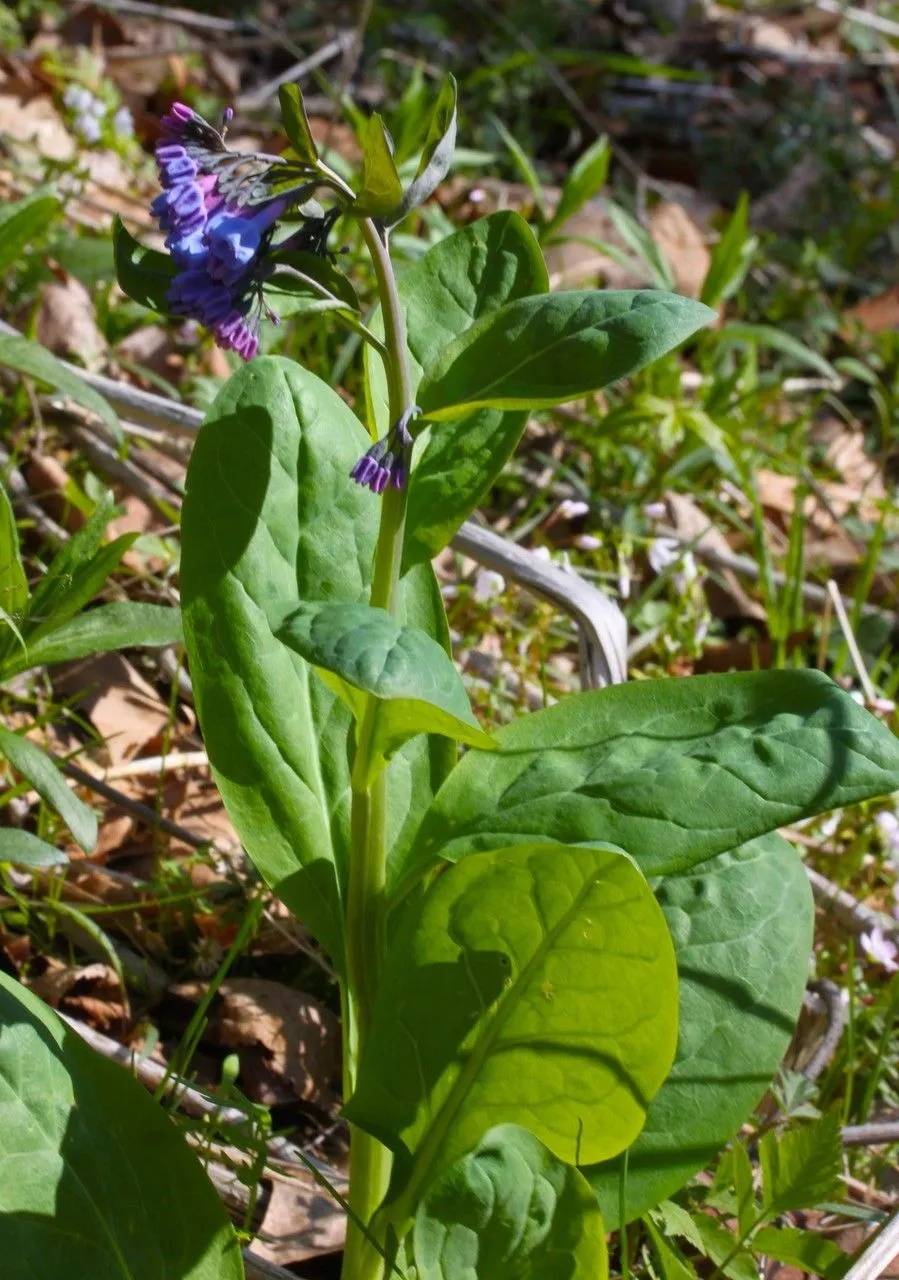
Author: (L.) Pers. ex Link
Bibliography: Handbuch 1: 580 (1829)
Year: 1829
Status: accepted
Rank: species
Genus: Mertensia
Vegetable: False
Observations: E. Canada to NC. & E. U.S.A.
Roanoke-bells, scientifically known as Mertensia virginica, are beautiful perennial wildflowers with a captivating charm that adorns the woodlands of Eastern Canada and the eastern United States, stretching down to North Carolina. With their delicate, bell-shaped blooms, Roanoke-bells hold a special place in the family Boraginaceae, resonating with both botanical enthusiasts and nature lovers alike.
The allure of Mertensia virginica lies in its stunning floral display. The flowers typically emerge in early spring, showcasing a vibrant palette that transitions from pink buds to striking blue blossoms, sometimes with hints of lavender. This color transformation is not just visually appealing but also plays a role in attracting pollinators such as bees and butterflies, essential for the plant’s reproductive cycle.
Roanoke-bells thrive in moist, rich soils commonly found in deciduous forests and along stream banks. They prefer a shady environment, which helps to protect their delicate flowers and conserve the moisture needed for their growth. These plants exhibit a clump-forming habit, with smooth, oval leaves that provide a lush green backdrop to their enchanting blooms.
Dating back to its first description in Handbuch 1: 580 (1829), Mertensia virginica has been appreciated not only for its beauty but also for its ecological significance. As a native species, it contributes to the biodiversity and ecological health of forested areas, offering habitat and nectar for various pollinators early in the growing season.
Despite the serene beauty of Roanoke-bells in the wild, they can also be cultivated in garden settings, provided that conditions simulate their natural habitat. Gardeners who wish to invite a touch of these woodland wonders should ensure adequate shade and moisture, allowing the plants to flourish similarly to how they would in their indigenous terrain.
Preservation of natural habitats is crucial to maintaining populations of Roanoke-bells, as their reliance on specific environmental conditions makes them susceptible to changes caused by deforestation and urban development. Efforts to conserve these areas are essential to protect the delicate balance of the ecosystems in which Mertensia virginica plays an integral role.
In conclusion, the Roanoke-bells are more than just a fleeting springtime marvel. They stand as a testament to the intricate beauty and complexity of nature, from their dynamic color-changing blooms to their role in supporting pollinators. Understanding and appreciating Mertensia virginica in both natural and cultivated spaces allows us to partake in the stewardship of our planet’s botanical heritage, ensuring future generations can witness the captivating allure of these woodland gems.
Eng: bluebells, roanoke-bells, virginia bluebells, virginia cowslip, eastern bluebells, tree lungwort, virginia lungwort
Fra: mertensia de virginie, mertensie de virginie
Deu: virginisches blauglöckchen
Swe: pärlemorfjärva
En: Roanoke-bells, Virginia bluebells, Virginia cowslip, Bluebells, Virginia Bluebell, Virginia lungwort, Eastern bluebells, Tree lungwort
Da: Virginsk Hestetunge
Fi: Helmiäishalikka
Fr: Mertensia de Virginie, Mertensie de Virginie
De: Virginisches Blauglöckchen
Is: Lotblálilja
Ml: മെർടെൻസിയ വിർജീനിക
No: Klokkeøstersurt
Sv: Pärlemorfjärva
Taken May 19, 2021 by sandy anks (cc-by-sa)
Taken Apr 19, 2021 by Adam Paul (cc-by-sa)
Taken May 20, 2019 by jenna (cc-by-sa)
Taken Feb 6, 2021 by Jennie Smith (cc-by-sa)
Taken May 16, 2020 by Barky Alot (cc-by-sa)
Taken May 26, 2019 by Bethany Nowviskie (cc-by-sa)
Taken May 14, 2020 by Michael David (cc-by-sa)
Taken Apr 25, 2019 by Donna Ashe (cc-by-sa)
Taken Apr 6, 2020 by ari Ruggiero (cc-by-sa)
Taken May 1, 2020 by Kathryn Zellar (cc-by-sa)
Taken Apr 22, 2013 by EOL − Dan Nydick (cc-by-nc)
Taken Apr 28, 2013 by EOL − Dan Nydick (cc-by-nc)
Taken Apr 22, 2013 by EOL − Kyle Copas (cc-by)
Taken Jan 2, 2015 by EOL − smwhite (cc-by-nc)
Taken Apr 29, 2014 by EOL − Fluff Berger (cc-by-sa)
Taken May 5, 2014 by EOL − David Yeany (cc-by-nc)
Taken Mar 26, 2003 by EOL − Steven J. Baskauf (cc-by-nc-sa)
Taken Apr 7, 2021 by Theresa (cc-by-sa)
Growth form: Single Stem
Growth habit: Forb/herb
Growth rate: Moderate
Ph maximum: 8.0
Ph minimum: 4.5
Family: Myrtaceae Author: (F.Muell.) K.D.Hill & L.A.S.Johnson Bibliography: Telopea 6: 402 (1995) Year: 1995 Status:…
Family: Rubiaceae Author: Pierre ex A.Froehner Bibliography: Notizbl. Bot. Gart. Berlin-Dahlem 1: 237 (1897) Year:…
Family: Sapindaceae Author: Koidz. Bibliography: J. Coll. Sci. Imp. Univ. Tokyo 32(1): 38 (1911) Year:…
Family: Asteraceae Author: A.Gray Bibliography: Pacif. Railr. Rep.: 107 (1857) Year: 1857 Status: accepted Rank:…
Family: Fabaceae Author: Medik. Bibliography: Vorles. Churpfälz. Phys.-Ökon. Ges. 2: 398 (1787) Year: 1787 Status:…
Family: Aspleniaceae Author: (Cav.) Alston Bibliography: Bull. Misc. Inform. Kew 1932: 309 (1932) Year: 1932…